 15Likes 15Likes
 |
|

8 Oct 2014
|
|
Registered Users
Veteran HUBBer
|
|
Join Date: Nov 2012
Posts: 132
|
|
|
Wow! Another Sponsor
Just wanted to take a moment and welcome the latest member to my sponsorship team - Yuasa Batteries!

I told them about all the stuff I'm trying to add to the bike (electronic intrument panel, heated grips, 2 more lights, bike alarm - all sponsored!!) and they had a battery at my house 4 days later!
For the complete list of my official sponsors please check out my sponsor page:
[url=http://www.alexandertolchinsky.com/main/?page_id=136]Sponsors
|

28 Oct 2014
|
|
Registered Users
Veteran HUBBer
|
|
Join Date: Nov 2012
Posts: 132
|
|
|
Oaxaca - Contrasts
Oaxaca: Contrasts
This chapter of my journey involves Ida. It is incredible how, after knowing each other for only a week, we are very much like an old couple. We do everything together, we enjoy each other’s company and make each other laugh constantly, we ride through beautiful landscapes at sunset, swim in virgin rivers… but always as friends.

Ida and I arrived in Tuxtepec, Oaxaca after months of anticipation. So far every Mexican I’ve met has proclaimed either Chiapas (my next state) or Oaxaca to be their favorite part of Mexico. Though we are still on the east side of the Sierra Norte which separates the steamy lowlands of Veracruz and Tobasco and the cooler elevations of the rest of Oaxaca, the people are already everything I heard they would be.
The great divide between the rich and poor is more apparent here than any other state I have visited so far. Almost every single person I’ve met has either been, or has a family member who is, an illegal worker in the U.S. Oaxaca is a beautiful and diverse state, with good fertile soil and clean rivers. But it is mostly farm land of one type or another and therefore there are those who own the farms and factories, and those who work there – there is almost no middle class. There are many artisans but they generally subsist around the poverty line like most other Oaxaqueños.
We are staying with Magdaleno and his family; but it feels like we are staying with the entire neighborhood. He introduces us to everyone, we have met almost 100 people in the last couple of days. From children to adults to family members… we have quickly become a part of their community. We spent hours playing with the kids last night – everything from futbol, basketball, tag, to general goofing around and roughhousing. I have spent every night playing with them so far. But the sweetest moments have been those lulls in craziness when we just sit and talk. Their laughter rings through the dense air and lifts me from my languor. Dripping with sweat and tired I still play and run around, I am filled with as much joy as they. It has been so long since I have been in a place where kids can run around freely without fear, where they can be kids as kids ought to be.
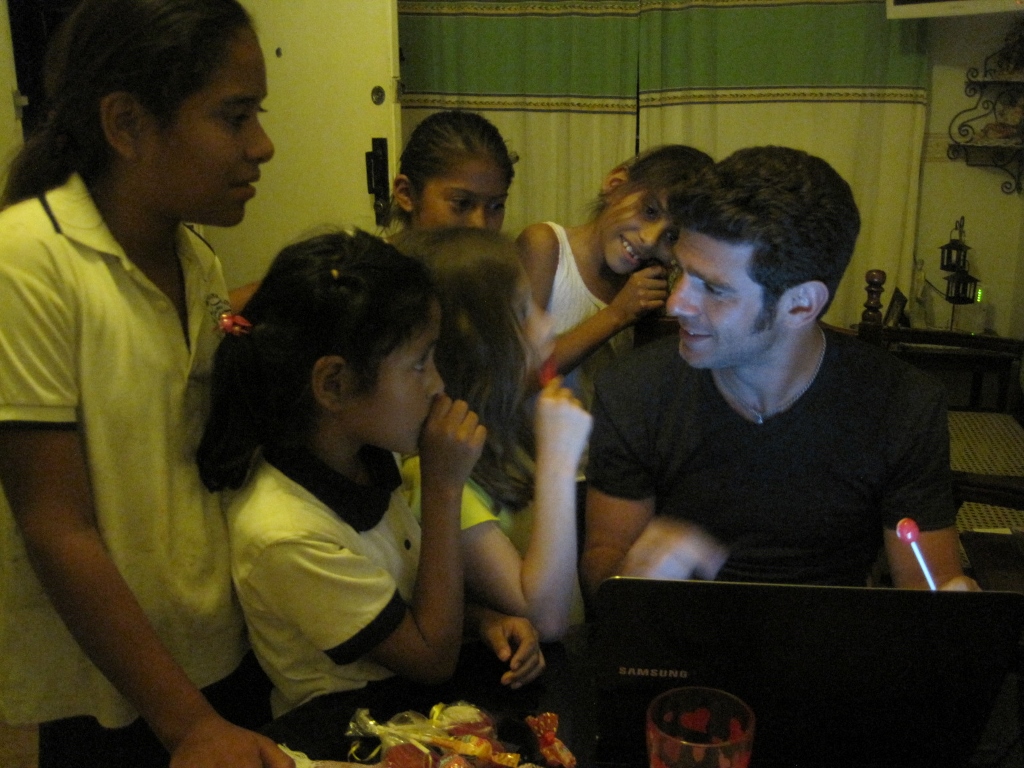
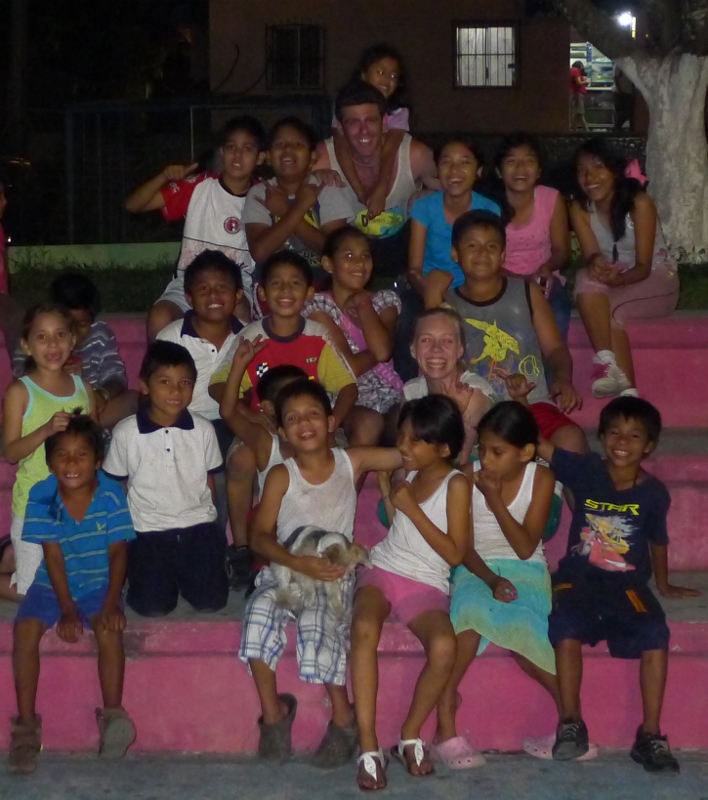
As is often the case with families from Oaxaca, Magdaleno’s father is in the U.S, as are a few cousins and uncles. Regardless of the money he sends home every month Magdaleno works and goes to school, his mother makes empanadas to sell on the side of the road, and Magda’s girlfriend comes during her lunch break at nursing school to help her future (hopefully) mother in law make and sell the empanadas. All of their hopes and dreams lie with the younger siblings for whom they are saving to build a future. For families who have not had generations cross the border in order to build some sort of financial base, the older siblings are generally left in a limbo between work and school. Most try as hard as they can to get as far as university, and hope that no disaster strikes forcing them to drop out and work full time. This constant state of the unknown allows them (if not forcibly) to live for today. This is reflected in everything they do and how they treat those around them.
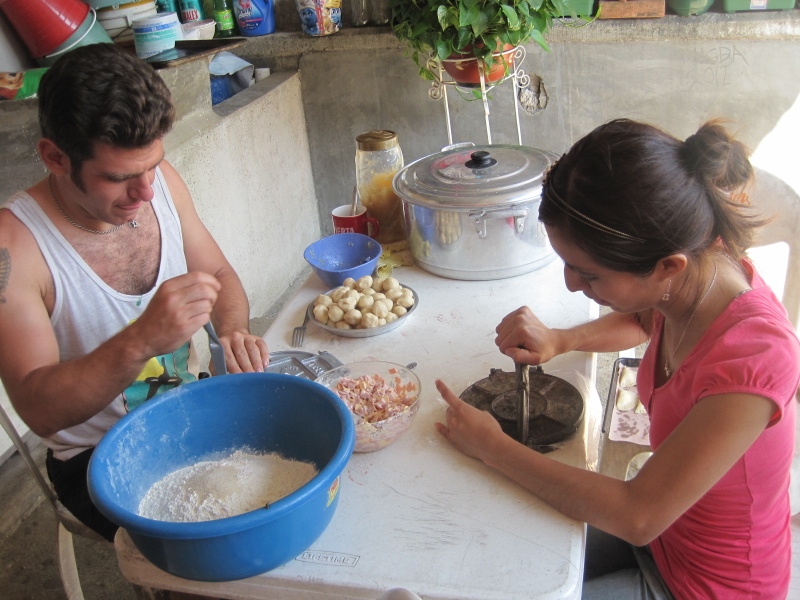
As has been true from the very beginning, it is those with the least who are the most generous. Everyone we’ve met lives around the poverty line, and yet it takes a great effort for us to buy something. Basically we have to go out of our way, and sneak around, to buy anything. Otherwise the  and food would flow unendingly for as long as we wanted. It matters not if it is all the money they have, they want us to feel welcome and to enjoy ourselves, and feel it is their responsibility to make sure that happens.
On one of our day trips to the nearby river, we met a local who was driving along the shore in his buggy. Ida mentioned she was trying to find an old coconut (coconuts which have fallen to the ground and have not been touched for a few months –the meat mixes with the water to form a delicious cotton like substance). The friend ran off right away and came back in about 15 minutes with two old coconuts. Then we started talking about food, and they mentioned there is a cheese made in their village (Chiltepec), again the friend ran off and brought back a kilo of fresh cheese, a pack of handmade tortillas and a bottle of coke. Thankfully Ida managed to slip him some pesos before he left. Then the local drunk joined us for conversation and food.
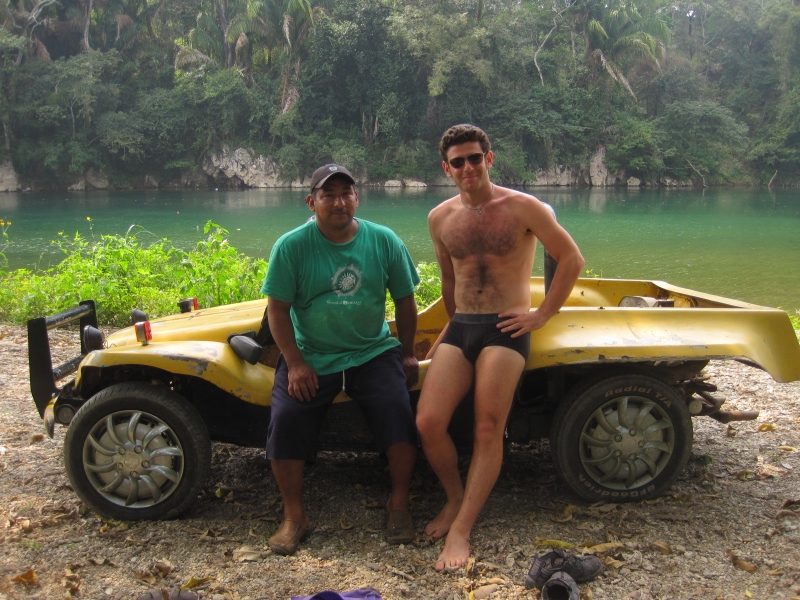
The day before we had gone to the source of the river at Zuzul. The water was perfectly clear and clean, and of the perfect temperature and sweetness. We spent hours walking and swimming and breathing in the clean air which is such a rare find in Mexico. On the way back, near every single bridge, we saw women and daughters as young as 7 doing their laundry; and men, women and kids bathing. The river is everything, and sadly it is also a point of refuse. Fortunately, close to the source it is clean and pure, and a few thousand people cannot contaminate the flowing water very easily, but the further you go, and as the river bends around more and more farms and factories, it slowly becomes undrinkable, and even un-swimmable. Again and again I bear witness to a complete disregard for nature.
This is the tropical, extremely hot and humid, part of Oaxaca. Sugar cane, bananas, pineapple, mango, and dozens of other tropical fruit grow here. The landscape is lush and diverse – with a mix of temperate and tropical trees, and everything in between. Tamarind and rubber trees, palms - what look like cherry blossoms, cloud forests, farms, grazing cows… metal and wooden shacks in danger of collapsing with every strong gust, hung with bright laundry flapping in the wind dot the rolling hills and climbing peaks. The contrast of gorgeous landscape and great poverty is very stark here.
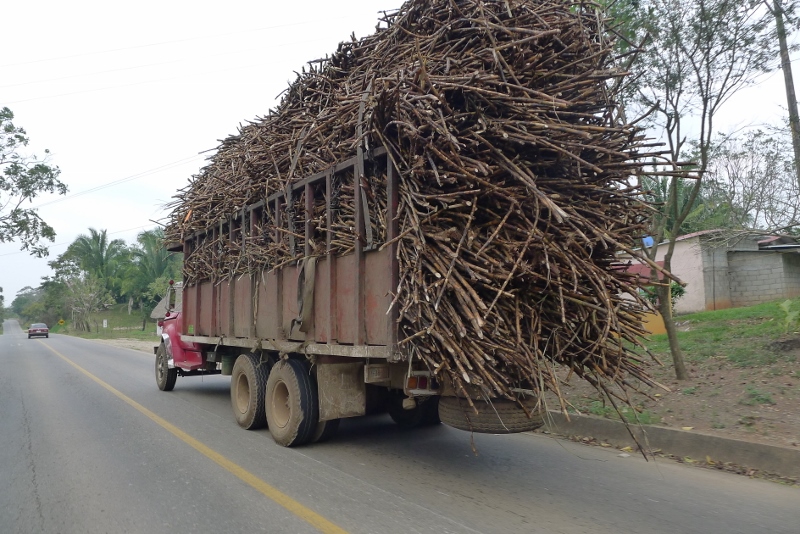
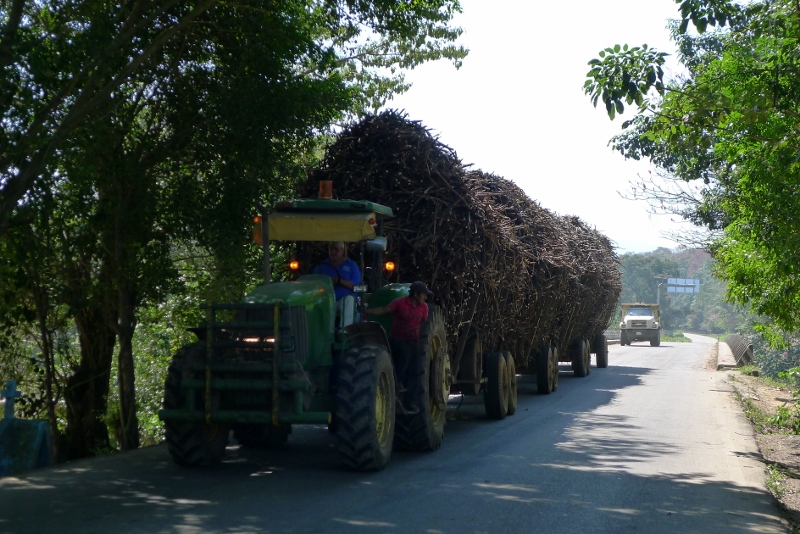
With a burning desire to seek the cooler climes of Oaxaca’s elevated plateaus and valleys, Ida and I bid a sad farewell to the community which welcomed us so warmly. For her the next day would be a tranquil bus ride through twisty mountain roads which eventually end in the capital, for me those very roads would simultaneously spell awe, wonder and constant brushes with death. It seems Oaxaca is determined to embody and manifest the yin-yang everywhere and in everything.
|

3 Nov 2014
|
|
Registered Users
Veteran HUBBer
|
|
Join Date: Nov 2012
Posts: 132
|
|
|
Oaxaca - Riding on the Edge
Part II of Oxaca, and the riding really starts!
Oaxaca: Riding on the Edge
Finally in the great city at the foot of three valleys!
This side of the Sierra Juarez is much cooler than the Veracruz side – thank god! We are surrounded by mountains and valleys. There has been a strong wind and a bit of rain, but the sky has made up for it with gorgeous sunsets and huge, beautiful clouds.
The drive to Oaxaca, over the breathtaking Sierra Juarez, was long and very difficult. Of the 200 or so clicks from Tuxtepec to Oaxaca, almost 150 go through the mountains. Of those 150, 100 or so you ride in 1st or 2nd gear, the other 50 in 3rd. The east side of the mountains was covered in a heavy fog for a good portion of the ride. The hairpin switchbacks gave no quarter of shoulder, rail, speed indications, or reflective posts. A mind blowing mix of trees and vegetation of the cloud forest rose into the mist on the left, as the unprotected cliff dropped off on the right. I wish I could have stopped to gaze on what looked like to be a magic forest – something out of a fantasy book, but the turns were blind and any car, coming from either direction, would have run me over with no more than a second notice.
This brings me to a continued observation from Veracruz, in which I noticed that cars in these two states pass in the oncoming lane with an air of propriety which forces those in their rightful lane to move over to the shoulder, if there is one. Basically, there is no right of way. With cars it’s one thing, but when semis do this, and they do this often, I fear the end of my days. When 2 walls of steel are coming at you, and the shoulder is but a dream, there is little you can do but pray. On relatively straight stretches of road, where there is warning, it’s one thing, when this happens in the mountains… At least 3 times I came around a corner to discover some 150,000 pound asshole trying to pass another semi - on curvy mountain roads!! I saw this in Baja as well, but it was never this close. In the last 4 months I have now had 15 close calls, in which a moment’s difference could have ended my life, or worse, put me in a wheel chair. New York was very dangerous, and I thought Mexico could never reach its heights, but it’s getting there. What’s worse is that I remember a great deal of the close calls I’ve had on my bikes over the last 10 years. It is scary how sometimes flashes from almost 100 instances of near death or possible paralysis come up from the subconscious. Every time I’ve had to stop and allow my heart to return to its rightful place in my chest is burned into my memory. For that matter, every freezing and/or soaked ride I can recall with incredible vividness as well.
But, as is the case with most days on the road, the tribulations are often soon forgotten for the triumphs and joys which abound. After being introduced by a fellow Mexican biker a few months ago over Skype, I’ve finally met Jayne and Phil - a brother and sister making the trek from Alaska to Tierra del Fuego ( Website: Ultimate Ride). We’ve been writing to each other and trying to cross paths for months now. Jayne and Phil are like friends of old. Our stories and conversations flow like the cascades of Angel Falls. It feels so good to have finally met up with them. I don’t know why there has been so much anticipation, but I think I see why now. They are wonderful, happy people, who share my passion for travel and the motorcycle. And burners to boot – an instant understanding of so many truths.


I’ve been alone for so long, but now, not only do I have Ida to share a little bit of my journey, but Phil and Jayne have also decided to throw in their lot for the next few weeks – we are a veritable caravan!
We began at the world’s biggest tree, in Mitla. It is awesome to contemplate how a single tiny seed can produce a living organism which weighs over 400,000 tons and grows 31m tall and 14m wide!
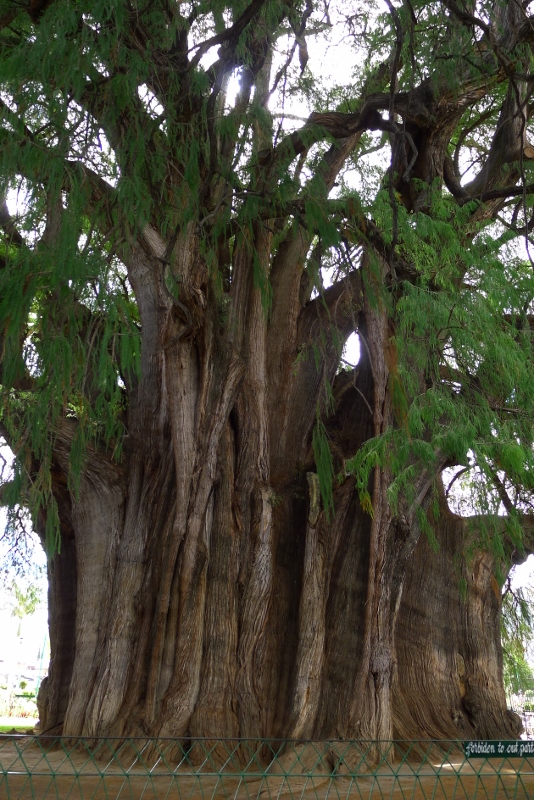

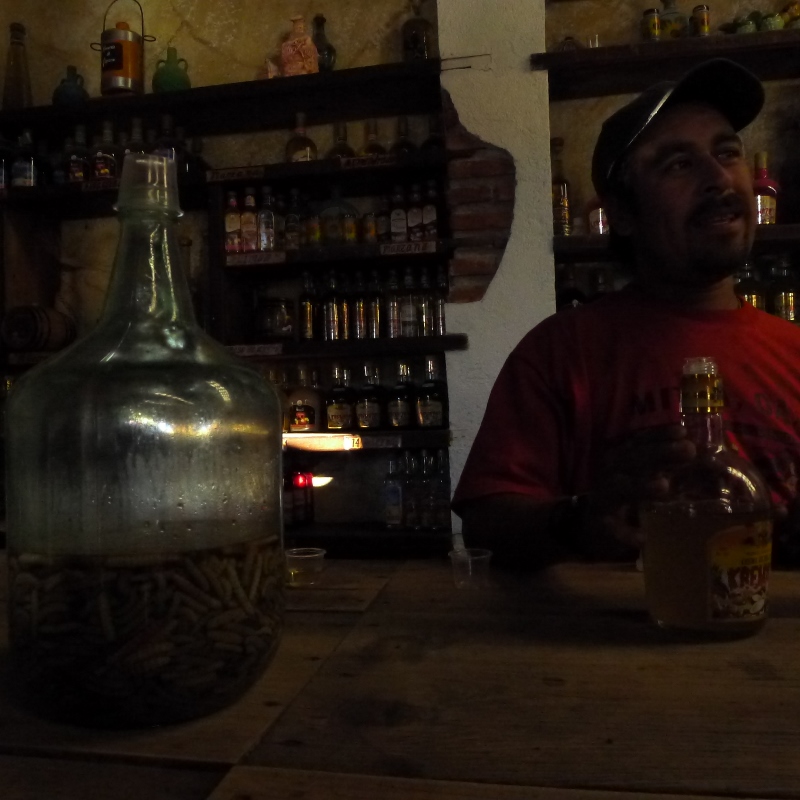
Then to calm our awe we proceeded on a tour of the local Mezcal producers… with plenty of tasting. And just to be sure we are well rounded and not just Mezcal slugging philistines, we took a 2 hour scorching hike up Monte Alban in order to sneak into the UNESCO protected ruins found at the top. This center of the Zapotec empire is majestic and grand… and so very hot. As fascinating as it was to trace with our fingers the works of masters past, it was shade and ice cream which we truly sought, and got by way of hitchhiking back to the city.
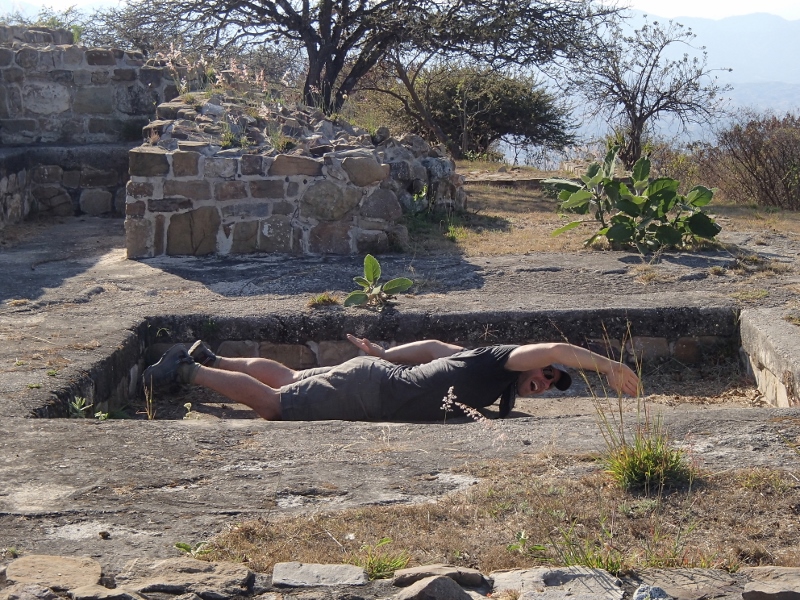
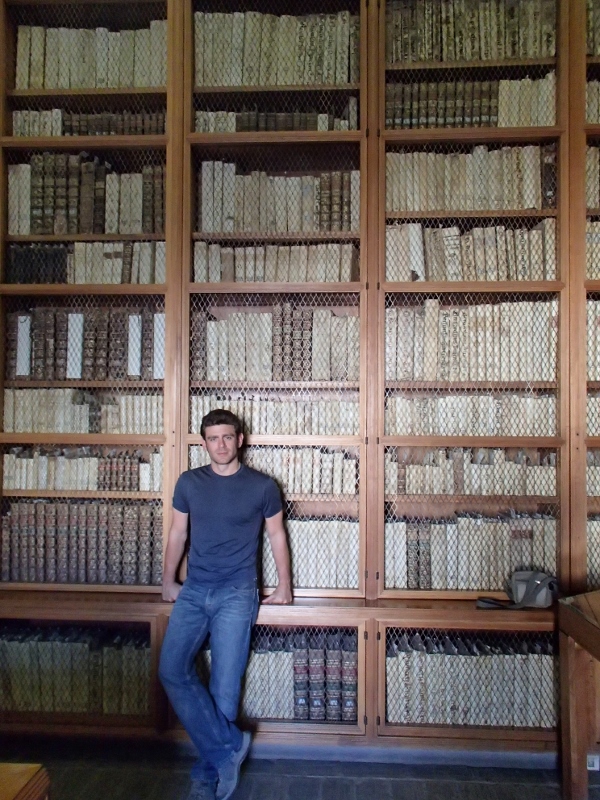
There are many things for which I have my mother to thank, not the least of which is my gift of gab. So much of my journey, so much enjoyment and open doors, have all come as the result of my ability to talk to people and to get along with them. That I can approach complete strangers and start up conversations has put me in contact not only with interesting people, but also those who have helped me along the way. My ability to get along with almost anyone has ensured that my experience staying with other people has been fulfilling and informative, as people open up and I am able to learn from them about their lives, countries and cultures. It is a gift for which I shall be forever grateful.
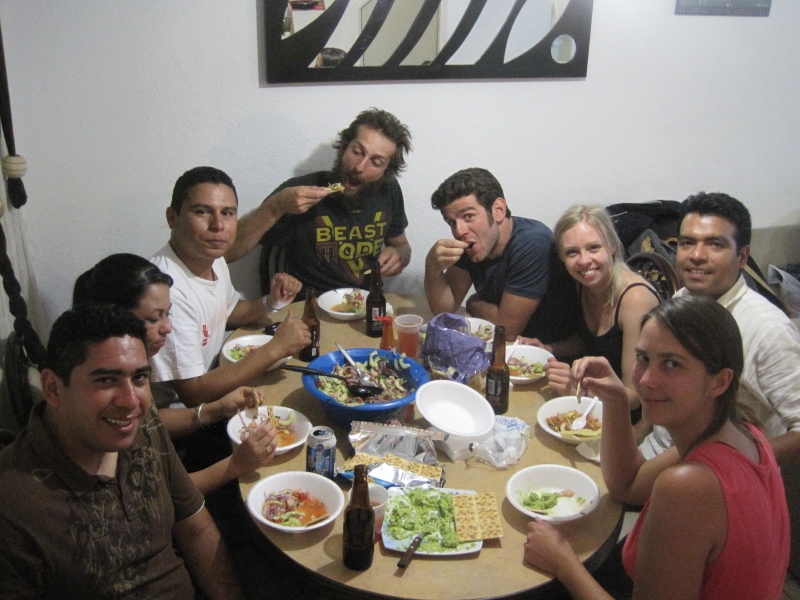
After spending a few days on a dank mattress in a dirty house with a dirtier bathroom, Ida and I found our way (thanks to Jayne and Phil) to the immaculate home of a military helicopter pilot. He invited friends to meet the lunatic bikers, we made ceviche and passed the long night in song and laughter. The following day Jayne, Phil, Ida and I left for the mountains and the relaxation in hot springs, followed by the adventure of finding lodging and riding through random mountain dirt roads which brought us to places white people rarely get to see.
|

4 Nov 2014
|
|
Registered Users
Veteran HUBBer
|
|
Join Date: Nov 2012
Posts: 132
|
|
|
Returning to the Road
Greetings Fellow Riders and Vagabonds!
For those in the U.S I hope you are voting!
I just wanted to let you all know that I will be returning to the road on December 2nd. I finally finished working on my mom's old house, and somehow managed to sell it. All is left is to bring the books and pots to storage, pack my backpack and return to my sick Georgia in Venezuela.
I hope you can understand the large lapses in time between posts as the last 9 months have been the most difficult of my life. It is no easier now, to be sure, but I pray the road will lend its healing powers forthwith.
I've started posting weekly again, and am writing furiously so that I may continue to do so.
Thank you all again for following my crazy adventure! I hope to meet more of you on the road soon!
Alexander
|

10 Nov 2014
|
|
Registered Users
Veteran HUBBer
|
|
Join Date: Nov 2012
Posts: 132
|
|
|
Oaxaca - Another World
Oaxaca: Another World
Jayne, Phil, Ida and I loaded up Cricket, Juggs and Georgia, and headed into the south-eastern mountains of Oaxaca. We sought to relax in the mineral springs of Hierve del Agua, but I secretly hoped for much more – and Mexico delivered as always.
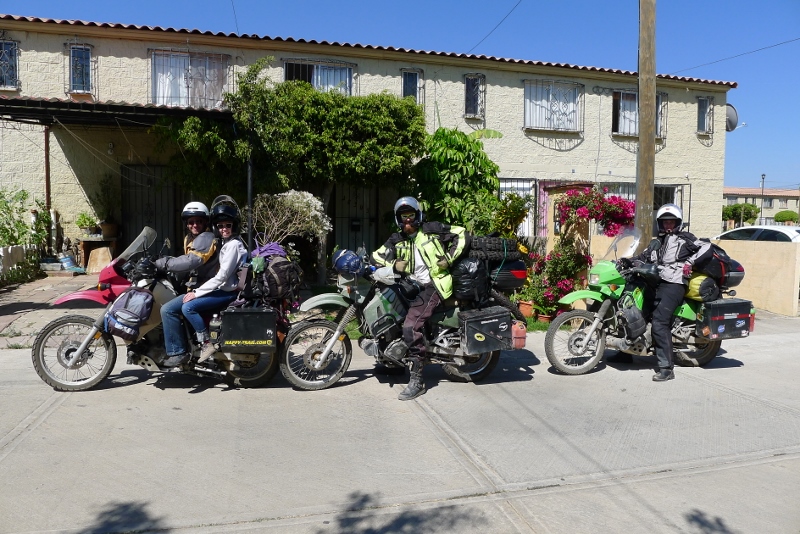
About an hour on the highway brought us to a great gravel and sand twisty going into the mountains. We passed a small village with the requisite poverty and ramshackle housing which seems to be the signature of Oaxaca.
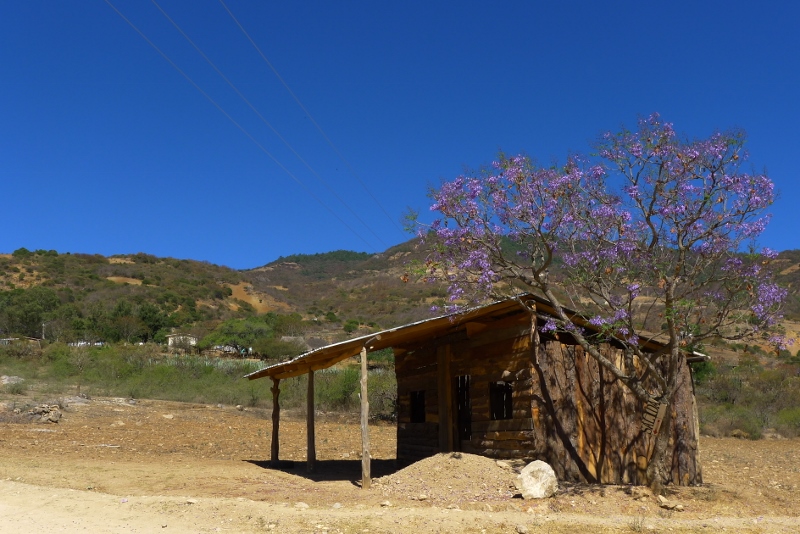
Hierve del Agua is not hugely impressive. Water bubbles up from the mountain and drains into a succession of pools, most tiny, but two large enough to swim in, one of the pools was not even particularly clean. However, the pools do overlook a valley, mountain ridges and a mineral cascade. It was relaxing and pleasant without needing to be stupendous or overwhelmingly impressive. After the excellent ride, we spent most of the day relaxing there.
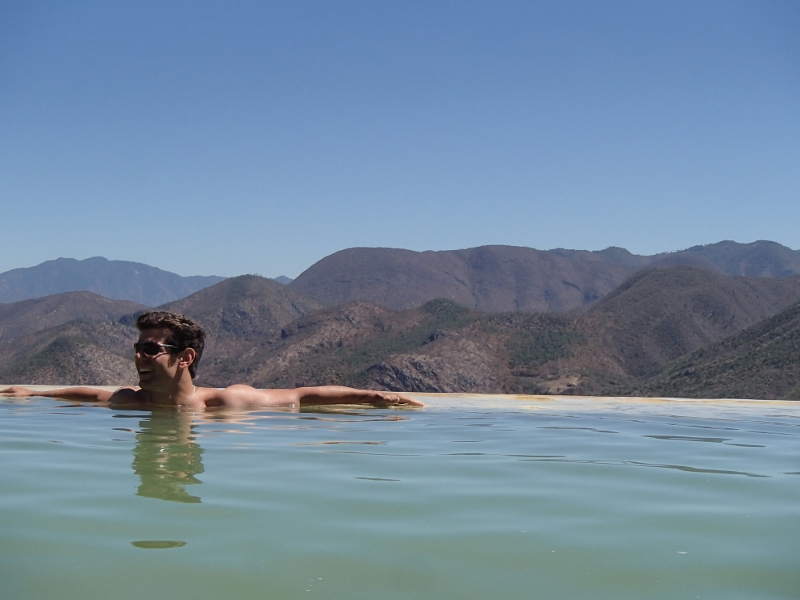

While we lounged in the water I noticed a snaky path winding its way up the opposing ridge and into the beyond of the sierra. I was not sure to where it lead, but I was sure I wanted to ride it. It connected somewhere with the road that took us here, and then would bring us to the middle of nowhere in the mountains opposite of where we were taking in the waters. It screamed of adventure in the views it promised to provide and the unknown to which it promised to lead.
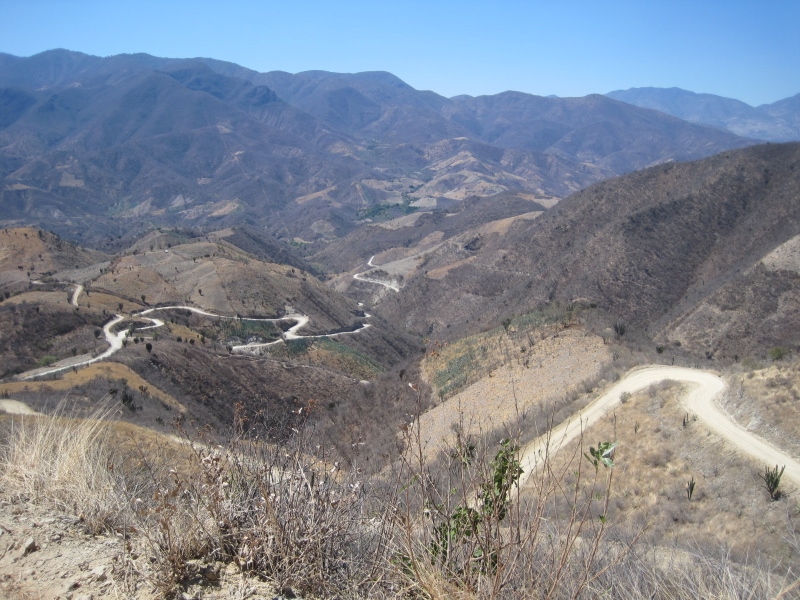
It was getting late and none of us had brought a tent or sleeping bags. For some reason we were not happy with the $8 per person rate of the cabins near springs, so we decided to head to the next village in the mountains to look for a place to stay. I knew there would be no motels at either of the villages, so we went with the hope of finding someone with a couple of extra beds. When we got to the outskirts of the little pueblo we began asking people, and everyone replied in the same way: go to the center and ask the authorities. Ask the authorities? All of a sudden we were in Europe during the dark ages. The authorities had to approve the wayward travelers before anyone could take them in, or be provided by the town with accommodations. It was odd, a bit inconvenient, but held promise of an interesting experience!
We turned a lot of heads riding into that pueblo. It was not on any tourist map, and it was not really on the way to anything, unless you were a Mexican Maguey farmer. For those without TV it is possible we were the first white people they have seen. White people, and on huge motorcycles! I would give anything to know what they were thinking. When we got to the little town center, there was a gaggle of kids, as always. Their playfulness and shyness and curiosity raged a great battle as they ran off giggling, but inevitably returned time and time again. Ida and I chose to play with the kids while Phil and Jayne went to seek the great authority of the town.
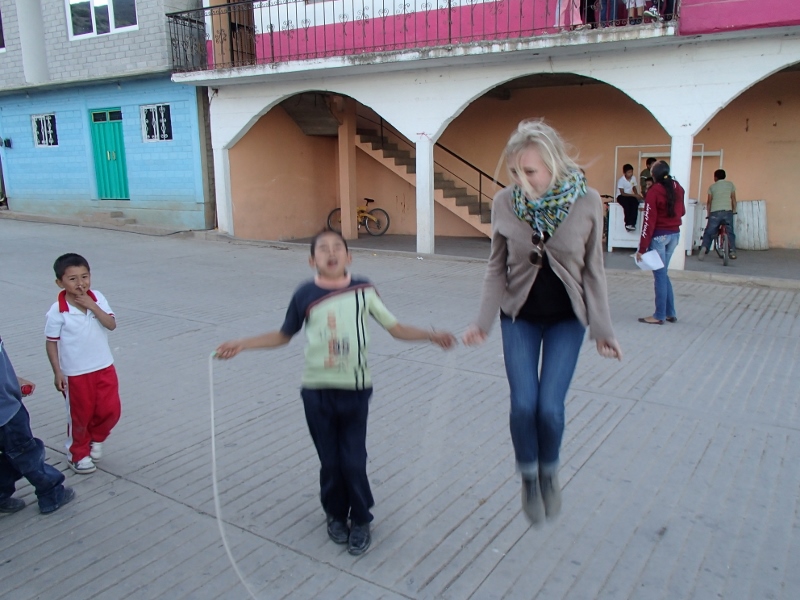
It was getting late - the sun was already scratching at the mountain peaks. The authorities were nowhere to be found and would not return for at least an hour and a half according to some helpful gentlemen we found around the town hall. Knowing Mexico, an hour and a half could easily mean sometime tomorrow. This is not a chance we could take. The guys did show us the likely room where we could be put up. It had nothing but a concrete floor, and possibly some light mattresses, but no blankets. We did not know how much, if anything would be charged, but we knew the night would be cold as we were in the mountains. It would be unlikely that the authorities would turn us down. But a night of bitter mountain cold was not something any of us were looking forward to. It was a nice idea for a little adventure, but when there was an affordable option which guaranteed warmth, we preferred to take that. At the end of the day we are not desperate. This is something I try to keep in mind: my homelessness and meagre living are a choice, as opposed to billions of people in poverty around the word. I am a relatively sane white man, and that means there is no way I could ever starve. There’s something so sad about the reality of that security.
We bought some bread and headed back toward Hierve del Agua. Right before the entrance there was a small restaurant, so we decided to take the chance and ask whether they had any room for us. They said they did, and only wanted 150 pesos ($12) for the 4 of us and our steeds. I took one look at the place, which had room in the little courtyard for our bikes, and knew this is where we were meant to stay.


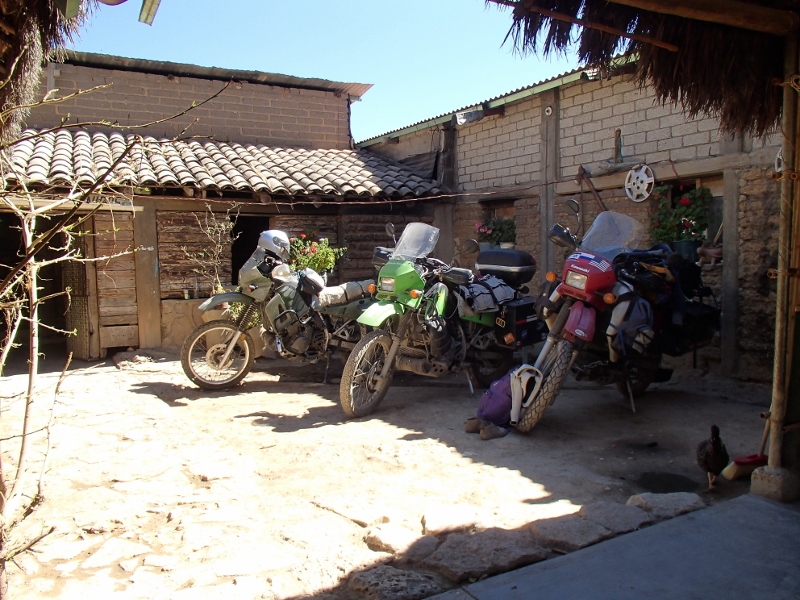
There was already a fire in the kitchen, and food in preparation. The land lady lent us some plates and knives to make our own guacamole, and put on a kettle of water to make tea from the yerba buena we brought from the market. We had not eaten in a long time so when the nopales and beans and tortillas started coming, we dug in ravenously. By then the guac was ready as well, and the lady brought out homemade mescal for us to try. All of a sudden, we went from not being sure where we would sleep and eat, to having comfortable, if small, beds and a feast worthy of the road.

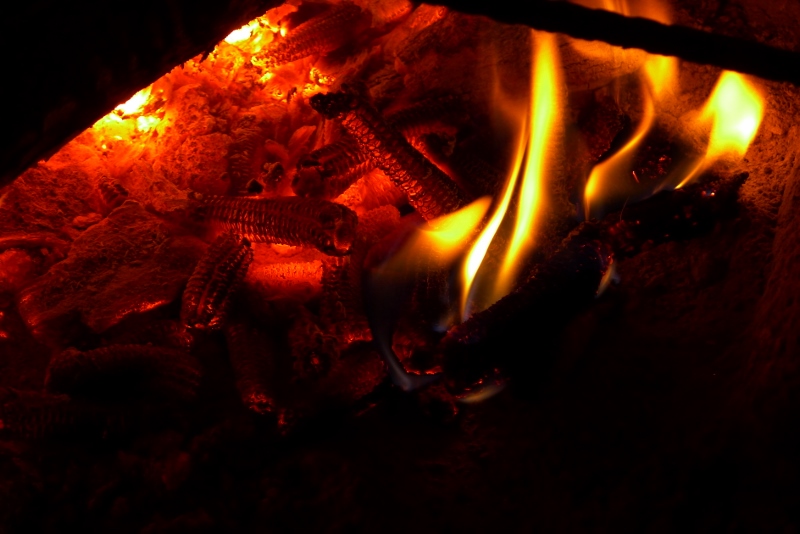
The following day we made our breakfast and took leave of our hosts. The road I had spotted the day before was now our route.


We passed through the village of the night before and within minutes found ourselves in the middle of the mountains. Hierve del Agua is also in the mountains, but just on the other side of a ridge from the main road to Oaxaca. Now we were truly in the middle of nowhere. The road was pure gravel and sand; it wound up and down the mountain sides, into valleys and along ridges. 80km of pure mountain riding. The forest kept changing, almost as fast as one side of a mountain to the next. Sometimes we saw cacti and palms, at others we were in pure pine forest. Much more often though it was an impossible mix of trees which seemed to come from different parts of the world. There was not much cloud forest as on the east side going toward Tuxtepec and Veracruz, but still a sufficient amount to make us stop often and wander at how such a mix could be found in such a small area.

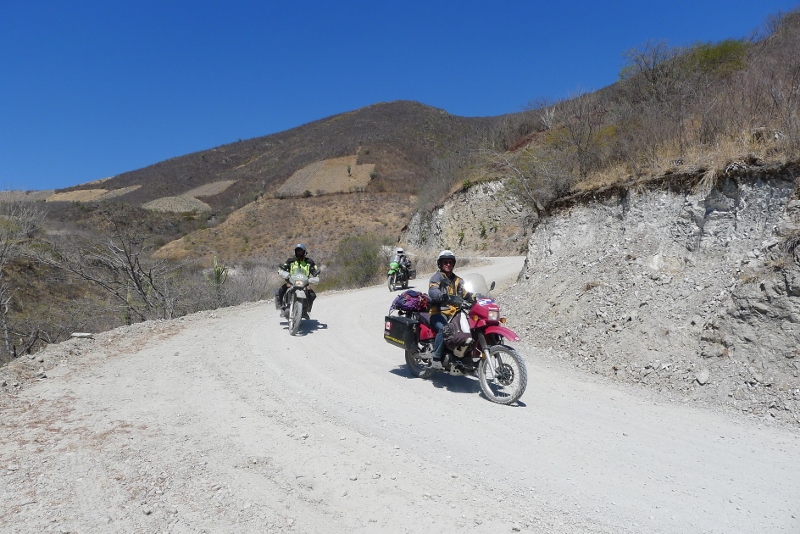
Maguey farms, or fields rather, dotted the mountain sides. For the most part the fields were tiny - either because each plants takes a lot of water from the surrounding ground, or to prevent infestation destroying large swaths. There were also maguey plants growing precariously on steep, rocky slopes, which made us wonder of the bravery or foolheartedness of the men who had to pick them. The only other people on the road came in small trucks to harvest the maguey, but for the most part were quite alone. In 80km we passed only a small handful of villages, and missed a few more which lay on tiny diversions from the main paths.

We were fortunate enough to meet a few residents of Santa Ana del Rio – a little village a world away from civilization. All of a sudden we were not listening to Spanish, we heard life in Zapoteco instead - A language that at one point dominated Oaxaca, along with Mixteca, but is now spoken by only a few thousand people. As Phil and I shared a hammock, and the ladies a bench, while we sipped our cokes to stave off the lethargy of the heat, it was Zapotec spoken around us as though it were normal. In fact not everyone spoke Spanish, my guess is that many there have never even left the mountains, or have seen white people (some probably have on TV, but for others we surely were the first – this is mostly true for the women and kids, not so much the men). We were in the middle of nowhere, and yet in another world. And here too, as other parts of Oaxaca, we found a missing contingency of men who have gone to the U.S to work and send money home.

We stopped by a small market and discovered something that would hold true for many markets in Oaxaca: they operate on a barter system. They will not accept the little money that others have, as they do not have much use for it, but they will trade tomatoes or avocados for a chicken or wood or clothes… something they can actually use. Some people are fortunate enough to have a small patch of land on which they can grow some fruit or vegetables to help feed the family.
The riding was fantastic! Pure off-road for 80 clicks with nothing but the ever changing forest and beautiful vistas that opened to every side of us.
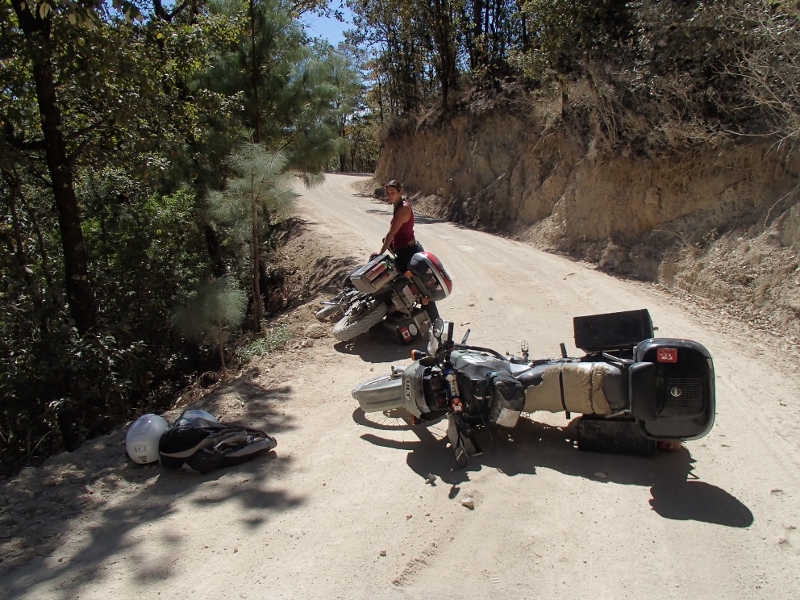
Jayne is significantly less experienced than Phil or me so she rode much slower, and even dropped her bike a couple of times. She was badly shaken up after almost dropping her bike off a cliff, so she rode even slower then. Considering the distance and the slow speeds it took us all of day light to make it back to the blacktop. Plus we stopped to help one of the villagers fix a flat tire. He was a few hours walk from his village, and as it was getting dark and there is practically no one there, we could not just let him go. Phil and I made a 30 minute job of it, give or take, and sent him with a questionable patch on his way. But all this meant that the last 2 hours of riding through the mountains, on paved road this time, would be in the dark. This is dangerous in Mexico, but in the mountains, especially in Oaxaca, it’s even more so. And of course the KLR headlamp did nothing to help us!


But in spite of all the obstacles – huge stretches of unpainted road, often with no signs or too many of them, no barrier and no reflective arrows or posts, even on sharp curves above high cliffs – we made it back in one piece. With our horrible headlights we were often driving on a prayer that the blacktop would continue and that we would stay on it.

We collapsed, thrilled and exhausted, on the beds and couches of our hosts, wondering, till the dreams came, of what adventures were yet in store for us in this magical land.
|

13 Nov 2014
|
|
Registered Users
Veteran HUBBer
|
|
Join Date: Nov 2012
Posts: 132
|
|
|
News!
Well, this is exciting: an online magazine picked up my story!
I will be posting to them once a week (starting from the beginning), and actually get paid for my efforts!!
It's not much, but it will sure help to sustain the crazy journey and subsequent book. I hope you guys will check it out and share with others as well - as I get paid per reader.
You can check it out here:
In Search of Common Bonds - Clapway
Don't worry, I will of course continue to post my pictures (which I promise will get better - at this point of the journey I only had a point and shoot, though a good one) and my stories on ADV.
Thanks again for following my insanity! I hope you continue to enjoy it, and maybe even get inspired to make one of your own!
Next post coming monday...
-Alexander
|

14 Nov 2014
|
|
Registered Users
Veteran HUBBer
|
|
Join Date: Nov 2012
Posts: 132
|
|
|
... sorry, I meant to say I will continue to post on ADV and HERE!!! I would not abandon my Horizons family!
|

16 Nov 2014
|
|
Registered Users
Veteran HUBBer
|
|
Join Date: Nov 2012
Posts: 132
|
|
|
Oaxaca: Sickness and Paradise
 Part I: Mountain
Part I: Mountain
Our little caravan is in a tiny village in the middle of the southern mountain range near Oaxaca. There is no cell signal, running water or internet. Phil and Jayne ran into a guy they had met earlier on in their Mexican travels, who then invited us to spend some time in his grandparent’s home in the mountains. We had the famed beaches of Oaxaca in our sights, but could not pass up the opportunity to not only pass through, but stay in an old Zapotec village.
Ricardo’s grandparents lived on one of the slopes of the surrounding mountains. Their property consisted of a few huts, surrounded by small patches of field where they grow a little coffee, corn, lemons and anything else they can manage in a given year. One of the huts is their home, so Ricardo and his 3 friends crowded inside another hut, while Jayne, Phil, Ida and I pitched our tents to the side.
What a little piece of heaven! Surrounded by ridges of tropical forest covered mountains, a creek rushing off to a waterfall nearby, the fresh air, the unbearably starry nights which slowly get washed away by a gently rising moon, peace… But like so many other villages, Santa Maria stands in the depths of poverty, unemployment and is nearly empty of men. The women, children and older men stay to attempt to manage the villages. Kids as early as 5 learn how to help their mothers wash clothes, clean house, cook and look after younger siblings. It is our heaven only because we can leave it.
Of course we are never made to feel as intruders, never out of place. We met many villagers, and spoke with them about local herbs and flowers, how the farms are faring, and their dreams of the mysterious world beyond their valley. We shared a simple but delicious dinner with Ricardo’s other grandmother, then spent the following day hiking through the valley and swimming in a perfectly temperate waterfall. The days could not have been more perfect…
Then I started feeling oozy in the stomach, and the clouds quickly gathered around my head, trumpeted on by donkeys, turkeys, roosters and dogs, who had not been silent for more than 5 minutes going on 3 days. I drank a coke and a bit of Mezcal and felt better. But then at night it came back with a vengeance and I spent most of the evening in agony trying to take and drink anything I could get my hands on. I wanted to throw up but I couldn’t, and nothing was helping. Finally I smoked a joint, which made things worse at first, but after about half an hour it kicked in full gear and I passed out. The next day I was still a little sick and very weak from the night before. And as Phil and Jayne packed their steeds to move onto Mazunte on the coast, I was left unsure as to whether I would be able to ride. The following day though I was back in the saddle, and Ida began her multi bus trek to meet me at the famed Pacific beaches of the Mexican Coast.
 Part II: Circus
Part II: Circus
Mazunte welcomed us with idyllic, hammocked beaches with light sand, an endless horizon painted daily with the suns full palate, a luscious coastline with cliffs and rich jungle vegetation… and a circus performance festival!
Acrobats, jugglers, fire spinners… each act more incredible than the last. The whole world made serene and vibrant with the help of local mushrooms. I was lost in a sea of sensation, and everything I saw brought me joy. Until of course I was in the actual sea and almost drowned, twice, after swimming too soon after a massage. All of a sudden the light of day became stark, and with every coughing release of the water trapped in my lungs, I felt my body shutting down. Finally I had made it to the beaches I’ve read about, seen in films, and dreamed for so long of visiting, and my paradise gets invaded with an infection which ran from my throat to the deepest reaches of my bowels.
I was gripped by a constant, painful cough, a runny nose, nausea and it’s inevitable travelling companion, lack of appetite and such a weakness that I could barely make it from the hammock to the bathroom. There was no pharmacy in town, and I kept praying that all the natural remedies I was trying would eventually heal me, or at the very least give me the strength to ride to the next town. But all the ginger and citrus in the world can’t kill the bacteria that was ravaging me. It turned out that a few people had caught this as a result of the road work they were doing at the time (on the only road in the god damn village). I was stuck in the very environment that was making me sick.
This gave me a few more days to observe the culture which has heretofore been quite foreign to me – the hostel. I rarely stay in a hostel (or hotel), I prefer, for many reasons, to stay with locals wherever I am. But now I was trapped and was able to observe what before was only piecemeal memories from hostels past. In almost any hostel, anywhere in the world, there are certain patterns which inevitably emerge. There is usually a representative or contingency of a few types of people, and their associated behaviors. There’s the overly sensitive about everything type – usually a white woman who will look for things that are offensive just to be offended. There are the leeches who always show up when you are cooking something, but rarely cook or buy food themselves; the hippies, the stoners, the musicians (my favorite), the yuppies “slumming” it; and the person who brings their ****ing child along – who inevitably cries and ruins everyone’s day. Conversations too generally revolve around the same topics: where you are from, how long have you been on the road, what you’ve seen, your future plans, Israel vs. Palestine, the role of the U.S in the world, what your views are of locals, arguments over views of locals, religion, and jam sessions – the only conversation I listen to if I can help it.
Though the greater part of the hippies and circus folk had departed, leaving the beach town smelling a little better, sadly the hammock has not been washed in a while so every once in a while there is a waft of someone’s resistance to “The Man”. And after 5 days of things getting only worse I could no longer take the smell or the chance that time would heal me, and I decided to move on. I thought at first that I only needed to leave the environment for my body to recover, so I aimed for finding a virgin beach somewhere just up the coast. It took so much strength and energy just to pack Georgia that I was afraid I would not be able to ride for more than 10 minutes. But I bid Ida farewell, somehow mounted my steed, and somehow made it to that virgin beach without crashing.
 Part III: Sea Turtles
Part III: Sea Turtles
Playa Grande doesn’t exist on any map, in fact the only sign you will ever see of its existence stands by the side of the dirt road where it meets the coastal highway, and which reads Playa Grande, 7km è. 7 clicks down a sandy dirt road will bring you to a tiny village of 60 souls. There is no store, there is no anything, it is not a place for visitors, Mexican or otherwise. And because of this the fine sandy beaches stretch to the horizon in both directions, and are home to sea turtle egg deposits. In fact every man in town takes his turn guarding the eggs (from dogs and people who wish to sell them at market).
I rode my bike right up to the sand line, where there was a convenient gazebo of sorts with a thatched palm roof. I acknowledged the gaggle of kids which instantly surrounded me, promised I would play later, hung up my hammock and passed out. That drive of just a couple of hours was more than I imagined my body was capable of.
I had found that virgin beach I was looking for, but all I could do was lie in my hammock. 6 days so far of coughing and weakness and 3 days of diarrhea. Orcas, dolphins, sharks and sea turtles in the water, endless miles of virgin coast, and all I can do is lay there. I picked up a book for the first time in a week, before I had not the energy to concentrate on reading. 24 hours out of the poisonous air of Mazunte and I was no better. I needed to find a place in a town where I can have access to a bathroom , as well as food and water and a shower, and maybe even a doctor if this continues.
The cough and weakness prevented me with playing with the kids who continue to gather around me every few hours. I promising them I would play later, or the next day, thinking I would start to feel even a little better, but I would disappoint them again and again.
If it’s one thing you can do when so debilitated, it’s reflect, and the bi-polar extremes of Oaxaca is a perfect subject. The nicest people I have met in Mexico, who are also the poorest. Some of the best riding, but by far the worst roads and some of the worst drivers. Excellent coffee beans, but no decent cup of coffee. Every kind of landscape you can imagine: from cloud forest, to tropical coast and mountains, to pine forest and temperate mountain to rich valleys and arid plains… the beaches are gorgeous, the water intense and warm. I wanted to spend so much more time there, I wanted to learn to surf and enjoy endless days in a hammock, but being sick and with Phil and Jayne egging me on from Chiapas, I am forced to move on before I’m ready.
The few days on the beach were not completely wasted however. As I lay awake in my hammock around 5am, I suddenly heard man doing something in a shed nearby. I couldn’t sleep anyways, so I got up to see what he was up to. And as I got around the little dune that separated us, I beheld a beach full of tiny sea turtles hatchlings crawling their way to the ocean. I was bearing witness to the birth of 55 creatures who would possibly live to be more than 150 years old. And then out of nowhere a dog ran onto the beach and snatched of little sea turtles. I can’t explain why that made me so upset, but it did, and I caught the dog and pried the baby turtle out of its mouth. As I held the turtle against the blooming morning sky, it began trying to swim through the air. No matter what it had survived, its goal was the big ole blue and it would stop trying to reach its home only with its last breath. It was such a beautiful moment – one of my favorites of the entire journey.

It was the perfect end to my stay on the beach. I couldn’t stand being sick any longer, I needed a doctor, and I needed fresh water and a bathroom. So I wearily packed my bags, and with a prayer and cough mounted Georgia… who proceeded to sink into the sand. Already exhausted, I dismounted, unpacked her, dragged her out of the sand with the help of some kids, repacked her, and somehow did not pass out. Then made it to Huchitan, many hours later, somehow.

I went to the doctor right away, who, as everyone suspected, prescribed cipro (a broad spectrum antibiotic). It’s something I should have had for traveler’s diarrhea anyway. And though I hate anti-biotics, 8 days of sick is just a bit too much to keep hoping garlic and honey will work. My general feeling of weakness was also scary – I was actually sleeping during the day! I don’t remember the last time I took a napped.
After a couple of days on the anti-biotic and I was feeling 80% better. My ass stopped leaking, and the prednisone suppressed cough was also started to calm. Being able to sit on a toiled, take a shower, and sleep in a bed helped as well. It also gave me a few days to check out yet another incredible market of Oaxaca. So many colors, so many kinds of food and art… I could try sea turtle egg, stewed iguana or grilled armadillo, then shop for a hand carved mask, or lovely stone and gem jewelry, or locally weaved clothes…
A few days with a kind family and I was strong enough to ride again. I still had a few days to go, but mounting my steed did not make me want to pass out, and that was a start. I couldn’t wait to catch up with Phil and Jayne, and to see the other of everyone’s two favorite states: Chiapas.
It took a long ride through mountains, and wind farms with gusts so strong I was thrown from one side of the road to the other, sometimes into trees and others into oncoming trucks, and I was dead when I arrived, but I finally made it to San Cristobal de las Casa, in the middle of Zapatista country and, for the first time, traditional Mayan land.
|

25 Nov 2014
|
|
Registered Users
Veteran HUBBer
|
|
Join Date: Nov 2012
Posts: 132
|
|
|
chiapas - Zapatista Country
San Cristobal
The famed Chiapas! Land of the Maya, the Zapatista, and the jungle; and the other favorite state of most Mexicans. Still sick from throat to gut, but on the road to recovery and excited to reunite with Phil and Jayne.
As a Russian, I was naturally drawn to learning about, and meeting, Zapatistas – a movement which seeks to return land to the natives, while building a community based government which is only loosely controlled by a centralized body. I bypassed the capital and came straight to the center of the Zapatista movement: San Cristobal de las Casas. Though not an official Caracol (Zapatista community/village), it is from where the ideas are brought to the rest of the world, and for those wishing to learn more about the movement the place to be. There are even some communities which are open to the public and to which a regular shuttle goes. Obviously I was not interested in anything like that, so I took it upon myself to ride deep into the jungle and meet the real Zapatistas.
I took a few days to enjoy San Cristobal, and spend some time with Phil and Jayne (the last for a very long time). A bit of sickness on their end slowed them down for a few days and I was able to catch up. San Cristobal is a place I have often since dreamed of coming back to. It is a lovely colonial town in the jungle skirted mountains of central Chiapas. The temperature is always cool, which makes me very happy. And it was the first place in Mexico I had found to have any coffee culture whatsoever. I was actually able to go to a few coffee shops and have a choice of the kind of bean I wanted and the manner in which it would be prepared. Granted it's the high tourist contingency that provides this luxury, still, I’ve been in long need of a good cup so I cared little why or how I got it. But the best part was that San Cris is the kind of place a writer can get lost in – whether through wandering the cobbled streets, the colorful markets, or just sitting with a pen for countless months while gazing into the surrounding mountainous beauty from his window.
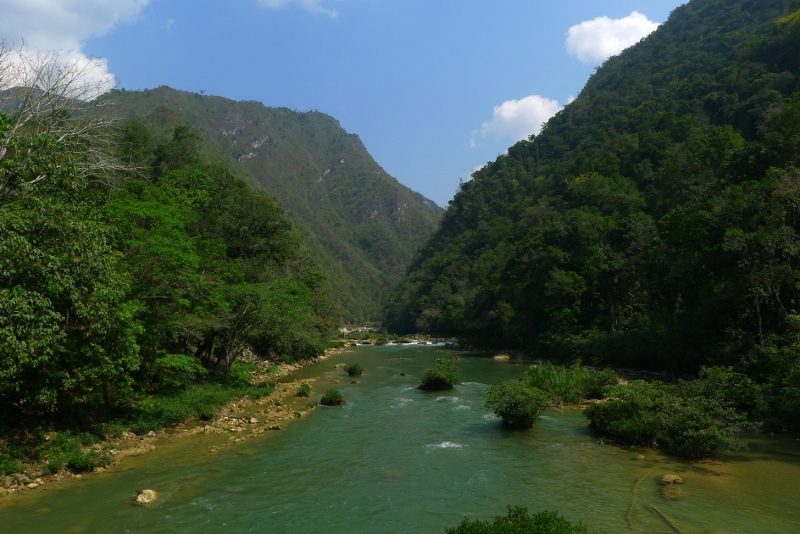
I took advantage of the few days rest I needed by camping at the gorgeous turquoise pools of, El Chiflon - one of the many waterfalls in Chiapas. Exotic butterflies of all shapes and colors circled around as though they were as common as flies, with the biggest butterfly I have ever seen outside a display case flying at incredible speed around me - it was the kind of radiant metallic blue that is so rare in nature you almost think it was painted that way. The ride to the waterfall gave me my first sense of Chiapas being another world altogether. Outside the two major cities of Tuxtla and San Cris, Chiapas reverts to the Mayan world. The faces are different than anywhere else in Mexico; the landscape is thick in jungle on one side, on the other the smell of pine perfumes the air; the languages and dialects are different from what I have heard before, as is the music and dress; and maybe it’s just my imagination, but there’s almost a smell of revolution in the air.
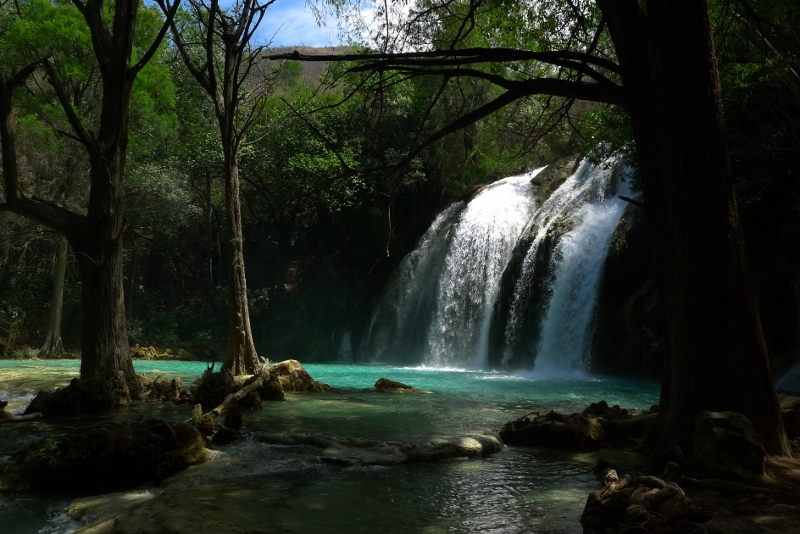
The next day I remounted my ailing Georgia, and ventured once again where white men don’t normally go, this time deep into the jungle in search of the elusive Zapatistas.
Zapatistas
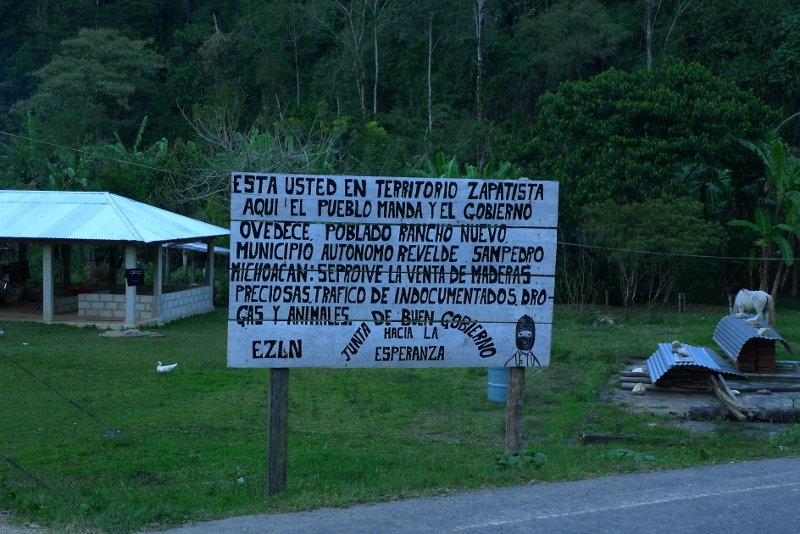
From Comitan to Las Margueritas not much changes in the way of landscape or political affiliation, but beyond the Margueritas you are in Zapatista country. The land starts to get divided into family plots, as opposed to larger farms and the pueblos are small and simple, if a little poverty stricken. None have running water, some don’t have electricity – the ones that do, don't have it for every house or building. The people are poor, but they all have their land, and have each other to help work it. They all grow a little bit of everything needed to sustain life: corn, beans, coffee, some livestock… but few fruits or vegetables other than the ubiquitous banana. The further south and east you go, the wilder the landscape becomes, until you find yourself in the middle of the jungle. Most villages are situated in forest clearings - at first tropical and pine, then pure jungle.
The road was twisty and slow – barely lit from the giant red ball of the sun peering over the upper reaches of the misty jungle peaks. I stopped to rest and talked to a tienda owner. He told me about San Jose del Rio – a Zapatista village down the road, . Though I was in a Zapatista village, it was clear that he did not want to deal with an outsider, so he sent me along. So I kept riding, stopping every now and again to just listen to the jungle. Sometimes there was pavement which brought me up to 3rd gear, at others I was happy to cruise along in 2nd. I generally don’t care about my speed, but the sun was quickly sinking behind the mountains, so when I reached San Jose del Rio, I pulled over to ask if there was a place I could stay, in my tent or otherwise. It is not normal practice to ask, let alone be allowed to stay in a Zapatista village. Normally a person would have to go through La Junta de Bien Govierno at La Realidad to gain permission to stay at one of the villages. But La Realidad was still far away, and this was not a road to ride at night.
Usually when I pass by villages I get stares or waves, but when I stopped at San Jose I got a crowd – clearly it was not normal for someone from the outside world to stop there. I asked to stay and speak with the Authority of the village. At first I was interviewed by some guy and woman for about 30 minutes, and only afterwards introduced to the Authority, who turned out to be a nice, 25 year old chap, with a wife and kid. The Junta picked him, he accepted, and now he is the link between his village and the heart of the Zapatistas.
At first he, and the people who interviewed me, were reluctant to let me stay, but they also did not want to send me out on a dark road which turned to dirt, and stayed that way for the next 120 kilometers. I was given a little spot behind the church where I was allowed to put up my tent (staying in a house was out of the question, in fact I wonder what would have happened if I did not have a tent). I was instructed to not go anywhere – no houses, no stores (of which there were 2), no walking around the village – if I wanted to go somewhere I would need an escort. I was told not to approach anyone to talk, but I was free to talk to people if they came up to me. It was also made pretty clear that I needed to leave first thing in the morning.
People were really nice to me (as is the rule in Mexico), and many came up to my tent, or to the table in the Authority’s mother’s house where I took my dinner and breakfast. I bought a bag of rice and bread to share, and brought out my jars of honey from Oaxaca. But I mostly ate what the mother had already made: delicious tortillas with beans for dinner, and coffee, tortillas and honey the next morning. It was weird to not be able to speak (or ask) freely, so I ended up learning little more than what I observed just by being there and passing through the many other Zapatista villages.
San Jose was situated in a small valley in the jungle of south-eastern Mexico. It was little more than some buildings and fences in a sea of lush green. At dusk the fireflies came out to add light to the music of the hundreds of bird and insect species surrounding the hills, which slowly died away with the last rays of the sun. It felt so peaceful. And then someone came by to tell me that the following day was the “village day” (dia de pueblo), so that night there would be a fiesta. So instead of falling asleep to the sounds of nature, I had to stuff earplugs in my ears to attempt to drown out the Banda music which played well into the night. Not at El Chiflon, not at San Jose, not even in the remoteness of Miramar was I been able to find solitude and silence. I wasn’t allowed to attend the party – for good reason I suppose, so instead I talked to the few people who came by my tent, put in the earplugs, took a Benadryl and prayed for sleep.
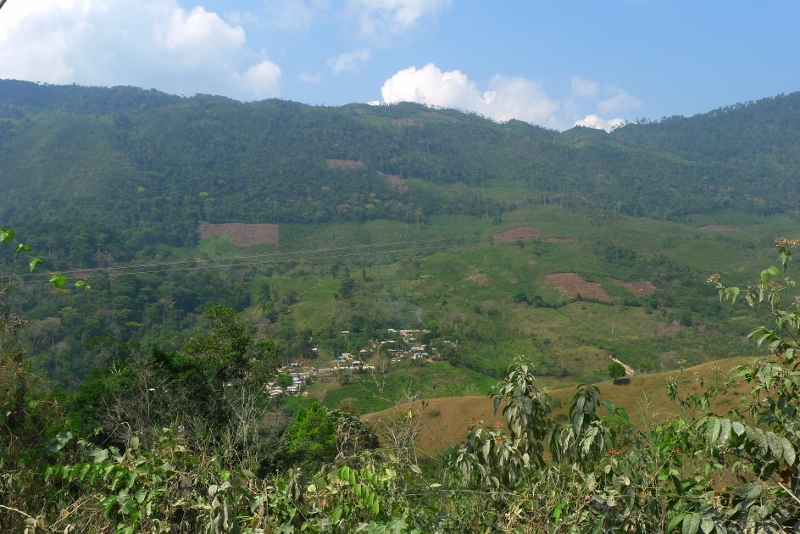
The following morning, after fresh picked, roasted, ground and prepared coffee, I took off for La Realidad in the hopes of actually speaking with someone in depth about the Zapatista movement and way of life. I was expecting something a little bigger, perhaps even a bit imposing, but La Realidad was little more than every other Zapatista village. After 2 hours of being questioned in depth about who I am, where I’m from, where I’m going, where I’ve been and what I want… and then waiting some more, I was told that no one would speak with me and I should carry on to Laguna Miramar (my next destination). I was very disappointed, but there was little I could do.

Here I was in the deepest point of Chiapas, and I couldn’t even remember what pavement looked like. Instead, a twisty road of sand and gravel - the color of limestone, with the ever shifting consistency of any single-track worth its name, was how I made my way deeper still into the jungle, in search peace and untouched natural beauty. At any point on the ride through the undulating hills and valleys of the jungle I had but to shot off my engine to become immersed in the sounds of the jungle. I did not need to hike for hours to isolate myself, the road literally cut through the jungle, so I was always in the middle of it. I couldn’t hear the various reptiles, but the primates, bugs and birds sure did sing a pretty, if sometimes deafening, tune.
I was not much more informed than before about the Zapatistas, but at least I was in the most beautiful part of an already beautiful country.
|

2 Dec 2014
|
|
Registered Users
Veteran HUBBer
|
|
Join Date: Nov 2012
Posts: 132
|
|
|
Back on the road
It took 9 months to come back to this point - being back on the road.
To be sure I don't know if I am really, losing my mom has sucked most of the life from me... but there is nothing I can do for my book, or self, sitting in my own misery, so I return to the life I've known the two and a half years before.
I just hope the road will more than reveal a place I want to live, and the common bonds which i seek for my book, but will too lend its healing hand to my shattered soul.
I will resume posting next week, and will continue every week like I have been doing as of late. After each country I will also put up a photos post with all the photos from the country.
See you out there...
Alexander
|

3 Dec 2014
|
|
Registered Users
HUBB regular
|
|
Join Date: Sep 2013
Location: South West France
Posts: 34
|
|
|
Thanks
Lovely descriptions, inspiring photos and always too good to miss. Thankyou
|

4 Dec 2014
|
|
Registered Users
Veteran HUBBer
|
|
Join Date: Nov 2012
Posts: 132
|
|
|
Thanks Canyon, I'm glad you're enjoying the ride along!
And I promise the pictures will get better... I was down to a point and shoot for a while...
|

8 Dec 2014
|
|
Registered Users
Veteran HUBBer
|
|
Join Date: Nov 2012
Posts: 132
|
|
|
Chiapas: Relics
Chiapas: Relics
Miramar
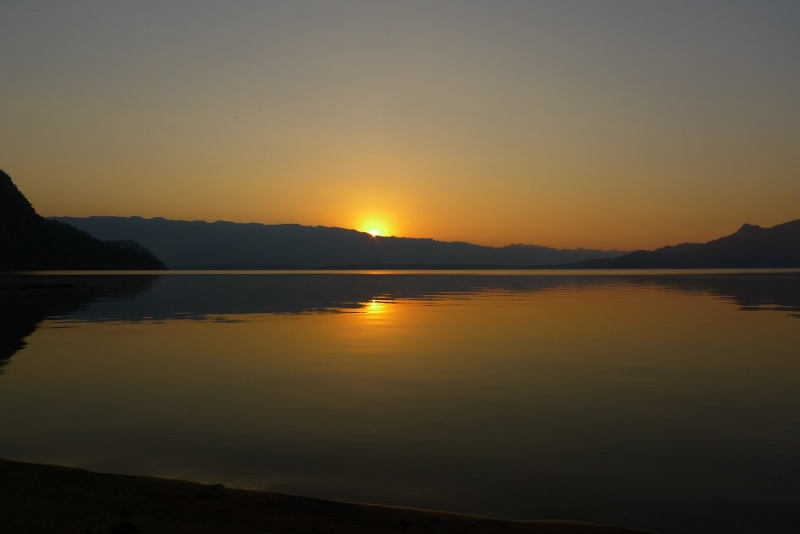
Laguna Miramar is one of those rare places in the world which has not yet been raped by man. It lies in the middle of the jungle, and though there are villages on its farther shores, there is no road that leads to it, so people coming to and from their home have to hike 6km, then row for a few hours. And just to make sure no one is too enticed to come, the hike is over unsteady farm land, with almost no signs at all that tell you where to go. And as a further precaution, the road that leads to the nearest village connected to the rest of the world, Emiliano Zapata, is mostly sand and dirt, which requires a good off-road vehicle, or a bit of craziness, to traverse. Georgia and I being accustomed to the difficulties of being in the middle of nowhere made it just fine, if a little tired from the riding and hiking, and wet from the constant rain.
Though I had to hide under a tree once or twice while the rain was particularly heavy, and my back was in pain from carrying my gear and food in a duffel rather than back pack, I put the 6km behind me in a matter of a few hours. It was almost dark by the time I arrived to the lightning and storm-cloud framed sunset. I smoked a joint which made the water look like it was vibrating, and watched the rain drops dance on the crystal clear lake, as the rolling thunder, the hum of insects and growl of howler monkeys, became my lullaby.
There were no mosquitoes, and the previous day’s rain dropped the temperature mercifully. I sat in the perfectly clean and warm waters of Miramar for hours on end – never hot, never cold. The sounds were incredible! Howler monkeys sounded like roaring dinosaurs, some birds like car alarms or mechanized pumps, while others sang like a choir of bells. The rain came and went again, and the lake returned to its perfect stillness, with the evening brought forth the sounds of animals theretofore asleep. It was a peace I wanted to hold on to, but as always there was something beckoning me to ride forth - in that instance it was my quickly expiring visa. I thought I would have finished Mexico within a month, but at that point was left with only 12 days on my 6 month visa.
After another day of sharing food and rocking in hammocks with some locals, I began the sweaty trek back to my steed. More lightly laden I made it in only a couple of hours, reluctantly put on my gear, and began the arduous ride back to civilization.
 Palenque
Palenque
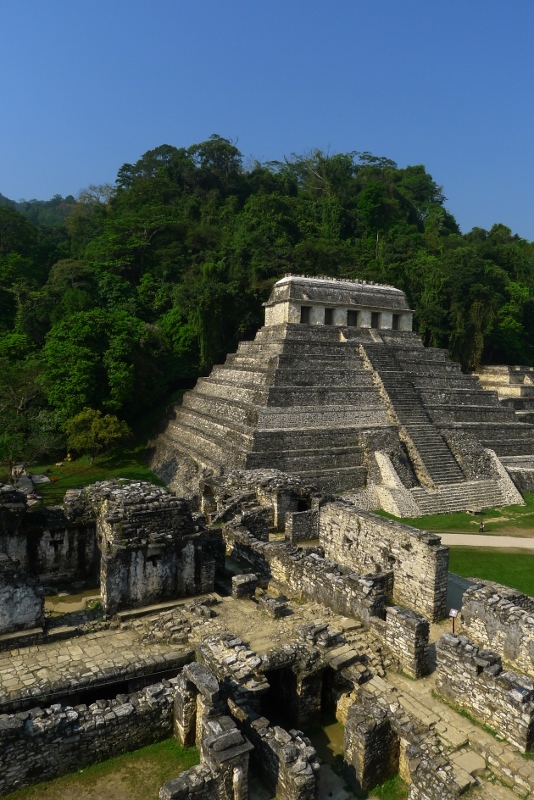
The jungle kept changing as I rode along, as did the dresses and dialects. No matter where I went it was the women who donned traditional clothing. As the men attempt to be worldly, it is the women who more often speak their native dialects. It’s often hard to tell from which part of Mexico a man comes, but with a woman it is much clearer. Even within the state of Chiapas, the dialects and dress changed, sometimes as often as village to village. The villages of women and children walking up dusty inclines with huge bundles of wood on their heads, could always be identified by the patterns in their skirts.

The sun and air were very hot which made for a lugubrious day of riding. The road remained dirt for a couple of hours, but thankfully stretched enough so that I could put Georgia into third gear every once in a while. I often had to pass little 15 seater vans – the only official form of public transportation. As a rule in Mexico, if it’s a 15 seater van, you can be sure there will be at least 25-30 people in it, which may or may not include people on the roof. In truth every type of vehicle is used for transport: cars, vans, small trucks, dump trucks, tractors, scooters… and each one will carry at least twice the normal capacity, with a good amount hanging-on precariously off the vehicle.
Eventually the pavement returned, and with it the joy of finding 4th and 5th gear. As per the usual I chased the sun into my little camp at the foot of the ruins at Palenque, and the following day I entered some of the most beautiful ruins I had yet seen. Set right in the middle of jungle, in the first hills which come out of the gulf coast plain, Palenque is one of the crown jewels of the Mayan empire. The architecture here is quite different from the rest of Mexico. Mexicas, Zapotecas and Toltecas have much more in common with each other than with the Mayans, and even an untrained eye like my own could tell. The whole site is quite impressive, not the least because everything that was built was done so without the assistance of the wheel or metal. I wish I could have seen these relics as they stood gleaming in bright reds and yellows against the deep green of the jungle in the back, and the brilliant blue of the uninterrupted sky of the plains in front. What a shame there are not many color drawings from the days of the conquest – only descriptions of how things were. In lieu of drawings, I walked around the entire site (no easy task in the jungle heat). I Took a bath and had a drink in the brook which ran alongside the upper part of the ruins, then went to the lower part which are set even deeper in the jungle and have two rivers running along the sides, with waterfalls, and snakes, and iguanas and butterflies…
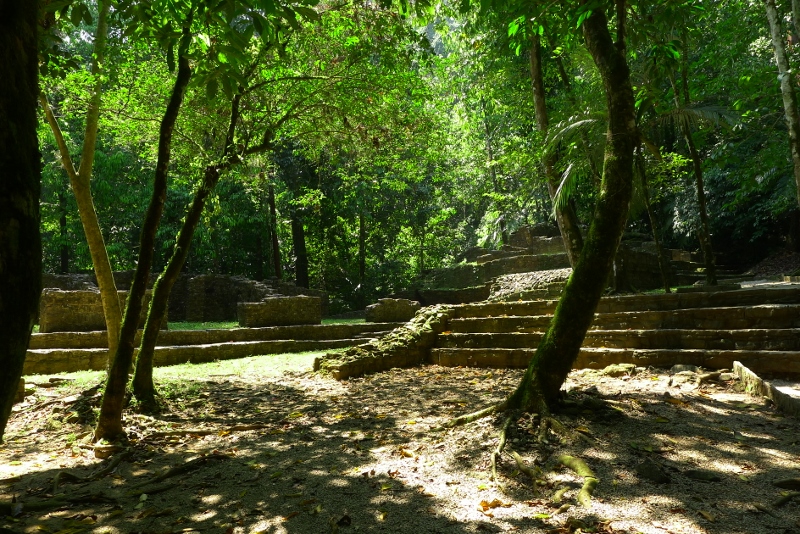
After 4 exhausting hours I walked another 30 minutes to my tent, which had by then been sitting in the sun all day. Everything inside was so hot I could barely touch it, the soap almost melted completely. I’m amazed I hadn’t lost everything on my computer - because it burned me like a skillet out of the oven. Apparently jungle sun is no joke. I had to bring everything into the shade to cool before packing it away.
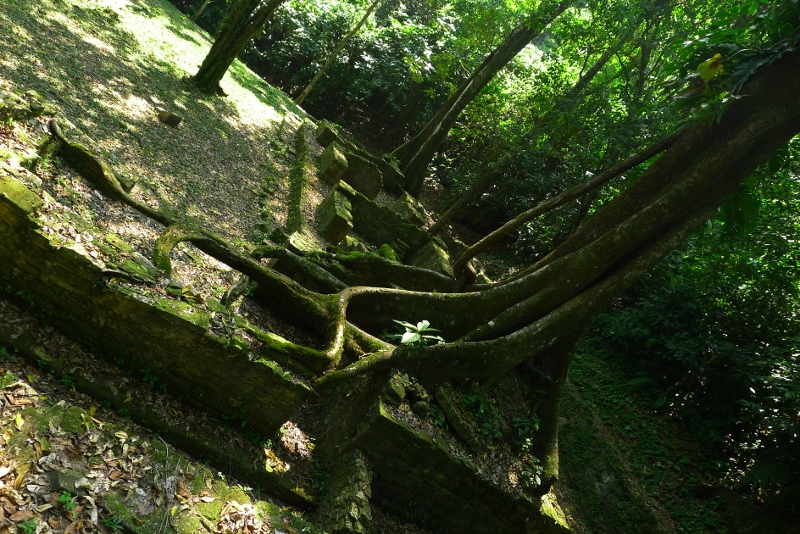 Campeche
Campeche
The ride to Campeche is one I would like to forget. Besides Georgia’s misfiring, which made the ride all the longer and painful (clogged carb), the road was flat, straight, with a scorched monotonous landscape on either side. At one point it got so hot that riding did not cool the air around me, instead it became hotter, like riding into a hair drier, or sitting in a sauna. What should have taken 2 hours instead took 5 as I had to constantly stop to drink, or retire to the few and far between gas stations with A/C. But as always, my stops brought me in touch with wonderful people. I met Victor, Jesus, and Daniel at a random stop on the road to Campeche near the gulf coast. It was a little shack serving fresh seafood, and the three truckers invited me to join them. We talked and laughed for a good hour, and then they bought my dinner! Just like that! I didn’t even get the chance to argue the point. It was not the first time that random kindness has been shown me by way of conversation and the fact that I am traveling alone, but that made this occasion no less special or memorable.
After a night’s rest in Campeche at a yoga center, I continued on the long dusty road to Merida, and a reunion with Ida. I was down to just over a week on my visa and could hardly bear the thought of leaving this magical land called Mexico.
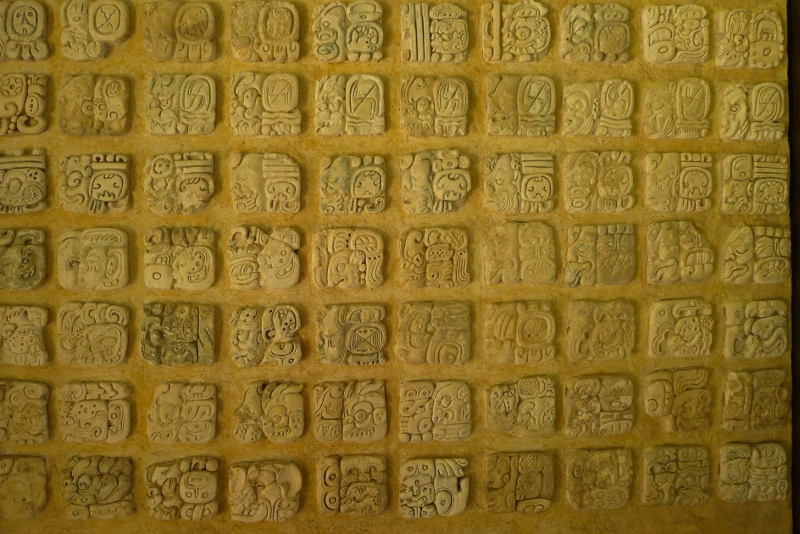
|

16 Dec 2014
|
|
Registered Users
Veteran HUBBer
|
|
Join Date: Nov 2012
Posts: 132
|
|
|
Mexico - End of the Line
Mexico: End of the Line
Though people would look at me askance whenever I told them I left on the day my visa expired, there was really no other way. I couldn’t bring myself to leave any earlier, I couldn’t bear to depart from Mexico. My last week there, on the Riviera Maya, was one of awe and mechanical difficulties. Though I had by that point recovered from my 3 weeks of illness, Georgia took up the banner readily and kept me in constant fear of stalling in the middle of nowhere.
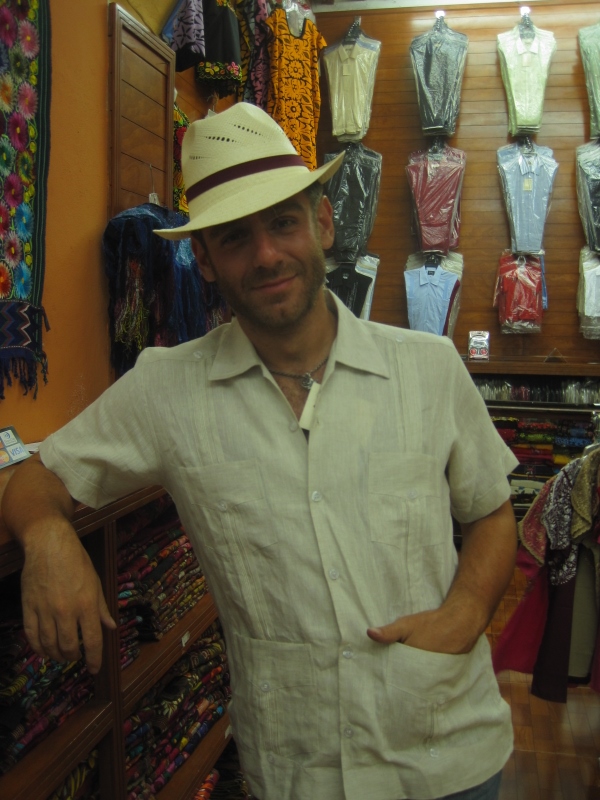
In Merida I was reunited with Ida, which was not only pleasant but quite fortuitous. Through her I was put in touch with one of the best mechanics I had ever met. Though I had tried to fix Georgia superficially, it required a masterful eye and experience to get her purring again, and Jorge was such a man. He diagnosed my problem quickly – which was a dirty carb – but not the main part, a smaller, air related diaphragm. He took it apart, cleaned it, checked the spark plug, cleaned that and the engine, replaced a bad rubber ring on a different part of the engine, cleaned and lubed the air filter, cleaned and lubed the chain, cleaned most of the bike… all for 300 pesos ($25). As always I spent the day with him while he worked, trying my best to learn something. His brother and father, also mechanics, kept me company. Moments like that really stand out for me, for one because I spent so much time with mechanics, but also because I was never kicked out of the shop, instead I was always given food and drink and invited to learn. And of the dozen or so mechanics that I visited, less than half charged me anything, the rest only something nominal – they were supporting me and my journey as best they could. I was a nobody, but I took the time to get to know them, to hear their stories and share my own, and so they chose to become an integral part of my journey’s success, and to them all I shall be forever grateful.


With the time on my visa ticking away rapidly, and an entire day dedicated to the mechanic, I was left with little to enjoy the incredible beauties, natural and historical, of the Yucatan Peninsula.
Ida and I began the day at a cenote (sinkholes in the lime-rich soil, mostly in Yucatan, but also present in Quintana Roo and Merida, which sometimes connect to underground cave systems and underground rivers). The water was perfectly clean and clear and of the kind of temperature which makes you want to stay in there forever. This one was mostly for locals as it didn’t appear on any cenote list that a tourist would see. The edge of the sinkhole was right over the water, so I was able to dive and cannonball in, enticing the kids to do the same. We dove into the depths of the cenote, perfectly visible in the crystal clear waters, and swam to the far reaches of the cave where stalagmites stood guard to a world which required scuba gear to behold. It was a perfect morning and early afternoon! We then came back to the city and walked around eating coconut, coffee and chocolate ice cream, churros, kibis, panuchas... We tried on some guayaberas and hats which made me momentarily long for the suits I could no longer wear. The next day we walked through the paseo Mantejo and the rest of the fancier parts of the city. It, along with Avenida Colon, is full of enormous, and I mean enormous, mansions - greatly ostentatious, but still appealing - built with new money at the turn of the 19th century. They imitate Greek and French architecture, with bright Caribbean colors. We walked along, talking and joking ( I still find it amazing how many inside jokes we share having only known each other a short time), and stopped for some food and cocktails at a place called La Bella Epoca. We sat on a balcony overlooking one of the main streets, plazas, and churches of Merida. There were horse-drawn carriages on the street, someone was playing a guitar and singing trova in a restaurant on the other side, the waiters were super polite, the tables clothed, the paintings of a dreamy time long since passed…
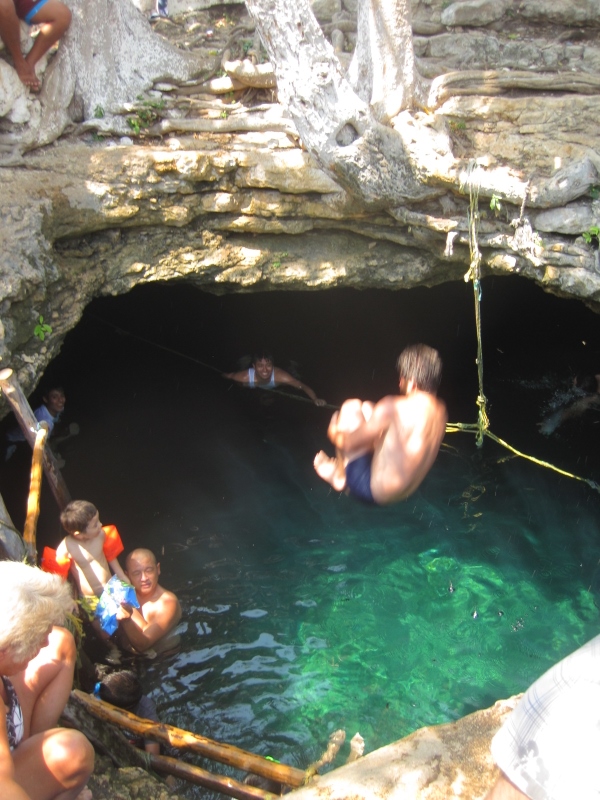

The following day I bid Ida yet another farewell, and rode through the perfectly paved, perfectly flat, perfectly straight, and perfectly monotonous, road to the Riviera Maya. The only other ride I can remember in the last 10 years that was as mind numbing was when I crossed the Dakotas. Except, at the end of this road lay the pristine, white sandy beaches of Tulum.
I only had a couple of days left to enjoy this Caribbean paradise before making a last minute run to the border with Belize. I did the requisite bit of snorkeling and touring around ruins, but mostly spent time reflecting on the last 6 wonderful months.
I had ridden through 20 of the states (2/3rds) and ended up the better traveler, the happier man, and a friend many times over, for the experience. I still, and forever shall, think often of the food and art in Michoacan, the mountains of Puebla, the music and dancing of Veracruz, the people of Oaxaca, the landscapes of Chiapas, the great desert, isolation and fish tacos of Baja, the mystical journeys of Morelos, and the insanity of the capital. I have never felt such freedom as I did in Mexico. It was so clear as to why there is so much great art and music, and why so many writers have at some point lived here – the freedom lets you breathe, it lets your creativity be inspired without constraint. And the people, with their open, kind hearts, who always have the time of day for you, make you feel welcome no matter where you are and no matter where you’re from.
A truly magical place.
|

26 Dec 2014
|
|
Registered Users
Veteran HUBBer
|
|
Join Date: Nov 2012
Posts: 132
|
|
|
Belize - An Oversight
There is little I can say about Belize because I never gave it the chance to give me something to say. Belize is an expensive country and that scared me right away. I hadn’t found too many people on couch surfing, and was generally not interested in the beach or any water based activity. There are some very lovely and interesting caves, but they too are very expensive. What is intriguing about Belize is the amalgamation of people who live in that little country, and though I only had a few days I was still able to notice to beautiful hodge-podge of languages and nationalities.
Chinese groceries and restaurants and general stores; Indian clothing stores; Lebanese Ice cream parlors… Creole, Spanish, English, Chinese and Indian dialects… Europeans, North Americans, Latinos, Indians, Chinese, Caribbeans, Middle easterners… and the insane mixes of the above. The lovely patua and Caribbean accented English is something I always loved, and was very happy to find on every dusty corner in every dusty town.
Most roads pass through low jungle, orange plantations, and tiny, unassuming villages. The landscape is not breathtaking like in Chiapas, but the tropical jungle of palms, fruit trees, furry hills hidden under a tangle of canopy, are restful on the eyes, and pretty to contemplate. It was too hot to stop for too long, so the roads, like Belize itself, are only a fleeting memory.
It was unjust for me to come and go so quickly, it is a mistake many travelers make at some point, and unfortunately it would be one I would repeat a number of times yet.
|
|
Currently Active Users Viewing This Thread: 1 (0 Registered Users and/or Members and 1 guests)
|
|
|
 Posting Rules
Posting Rules
|
You may not post new threads
You may not post replies
You may not post attachments
You may not edit your posts
HTML code is Off
|
|
|
|

Check the RAW segments; Grant, your HU host is on every month!
Episodes below to listen to while you, err, pretend to do something or other...
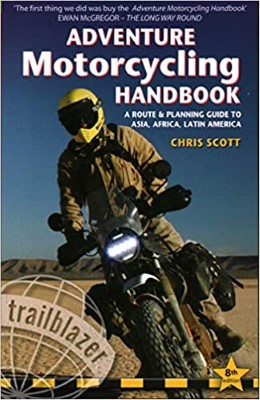
2020 Edition of Chris Scott's Adventure Motorcycling Handbook.
"Ultimate global guide for red-blooded bikers planning overseas exploration. Covers choice & preparation of best bike, shipping overseas, baggage design, riding techniques, travel health, visas, documentation, safety and useful addresses." Recommended. (Grant)

Ripcord Rescue Travel Insurance™ combines into a single integrated program the best evacuation and rescue with the premier travel insurance coverages designed for adventurers.
Led by special operations veterans, Stanford Medicine affiliated physicians, paramedics and other travel experts, Ripcord is perfect for adventure seekers, climbers, skiers, sports enthusiasts, hunters, international travelers, humanitarian efforts, expeditions and more.
Ripcord travel protection is now available for ALL nationalities, and travel is covered on motorcycles of all sizes!
What others say about HU...
"This site is the BIBLE for international bike travelers." Greg, Australia
"Thank you! The web site, The travels, The insight, The inspiration, Everything, just thanks." Colin, UK
"My friend and I are planning a trip from Singapore to England... We found (the HU) site invaluable as an aid to planning and have based a lot of our purchases (bikes, riding gear, etc.) on what we have learned from this site." Phil, Australia
"I for one always had an adventurous spirit, but you and Susan lit the fire for my trip and I'll be forever grateful for what you two do to inspire others to just do it." Brent, USA
"Your website is a mecca of valuable information and the (video) series is informative, entertaining, and inspiring!" Jennifer, Canada
"Your worldwide organisation and events are the Go To places to for all serious touring and aspiring touring bikers." Trevor, South Africa
"This is the answer to all my questions." Haydn, Australia
"Keep going the excellent work you are doing for Horizons Unlimited - I love it!" Thomas, Germany
Lots more comments here!
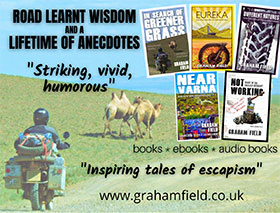
Diaries of a compulsive traveller
by Graham Field
Book, eBook, Audiobook
"A compelling, honest, inspiring and entertaining writing style with a built-in feel-good factor" Get them NOW from the authors' website and Amazon.com, Amazon.ca, Amazon.co.uk.
Back Road Map Books and Backroad GPS Maps for all of Canada - a must have!
New to Horizons Unlimited?
New to motorcycle travelling? New to the HU site? Confused? Too many options? It's really very simple - just 4 easy steps!
Horizons Unlimited was founded in 1997 by Grant and Susan Johnson following their journey around the world on a BMW R80G/S.
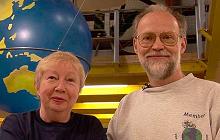 Read more about Grant & Susan's story
Read more about Grant & Susan's story
Membership - help keep us going!
Horizons Unlimited is not a big multi-national company, just two people who love motorcycle travel and have grown what started as a hobby in 1997 into a full time job (usually 8-10 hours per day and 7 days a week) and a labour of love. To keep it going and a roof over our heads, we run events all over the world with the help of volunteers; we sell inspirational and informative DVDs; we have a few selected advertisers; and we make a small amount from memberships.
You don't have to be a Member to come to an HU meeting, access the website, or ask questions on the HUBB. What you get for your membership contribution is our sincere gratitude, good karma and knowing that you're helping to keep the motorcycle travel dream alive. Contributing Members and Gold Members do get additional features on the HUBB. Here's a list of all the Member benefits on the HUBB.
|
|
|







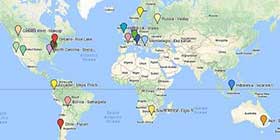











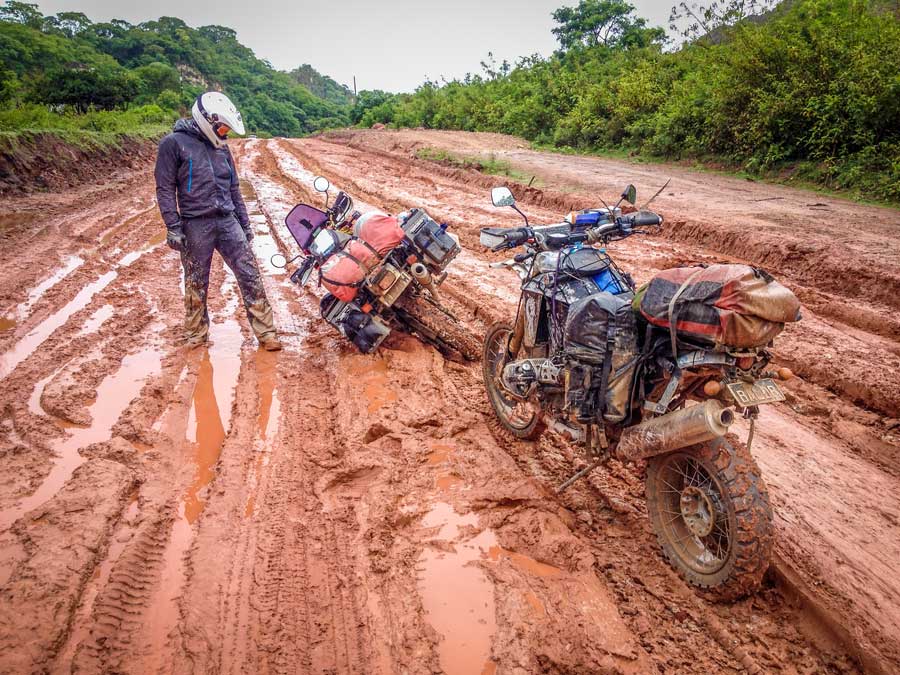
 15Likes
15Likes












 and food would flow unendingly for as long as we wanted. It matters not if it is all the money they have, they want us to feel welcome and to enjoy ourselves, and feel it is their responsibility to make sure that happens.
and food would flow unendingly for as long as we wanted. It matters not if it is all the money they have, they want us to feel welcome and to enjoy ourselves, and feel it is their responsibility to make sure that happens.






















































 Linear Mode
Linear Mode









